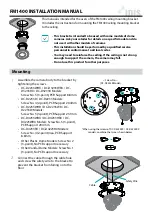
350-20053
14
3.3. 2-channel lighting
The use of 2-channel lighting provides optimal control and significant
energy saving.
Channel 1: If the sensor is activated manually, the lighting is switched
on/off automatically, depending on the preset lux value, in relation to the
measured light level and movement.
Channel 2: The lighting is switched on and off manually. Channel 2 is also
switched off when the cut-out delay expires.
3.4. Detection zone
The detector 350-20053 is designed for mounting on a ceiling. When
mounted on a height of 2.5m, the sensor detects activity over a diameter of
20m and motion within a zone of 360°. The detector has a lens area with a
diameter of 5m and over 618 fields that guarantees an optimum detection
of the slightest motions. Mount the 350-20053 on the ceiling at a height of
2.5m to 3.0m. Position it above the desk, at approx. 1m away from the seat.
The sensor has an optics with 2 detection zones: one for small distances
(A + B) to detect small motions and one for larger distances (C + D) to
detect body motions. This combination guarantees excellent lighting control
and optimum energy saving (fig. 5). If the detection zone is too large, you
can limit it by mounting the supplied cover. This enables the max. reach
of Ø20m to be reduced to Ø12m, Ø5m or Ø3m. The angle of 360° can be
reduced in steps of 45° (fig.6).
4. SETTINGS
(fig.7)
The 350-20053 is supplied with two test mode functions: one for a lux
test and one for a PIR test.
4.1. Lux TEST mode: measuring the level of daylight
Switch on the contacts DIP1 and DIP2. In this position, the lighting is switched
off. Slowly turn the lux button from min. to max. until the integrated indicator
(LED) is switched on. At this point, the lux setting is identical to the daylight
level measured by the sensor. If the lux button is turned to the min. value,
the lighting is switched off at a lower level of daylight. If the lux button is
turned to the max. value, the lighting is switched off at a higher level of
daylight. Finish by switching off the contacts DIP1 and DIP2.
4.2. PIR TEST mode: testing the PIR function
Switch on the contacts DIP1 and DIP2. Due to the PIR activation, the lighting
is switched on for 5s. The integrated indicator (LED) indicates that the PIR
is activated. Attention: During this test, the daylight blocking is disabled.
Finish by switching off the contacts DIP1 and DIP2.
4.3. LED indication ON: indication of PIR activation
Switch on the contact DIP1. You are recommended to switch off this contact
if you do not wish to indicate ‘supervision’.
4.4. PIR sensitivity setting
Contacts DIP3 and DIP4 enable you to set the sensor’s sensitivity.
The factury settings of the PIR sensor are:
• sensor in automatic mode;
• LED is off;
• high sensitivity.
5. TROUBLESHOOTING
5.1. The lighting does not switch on
- Turn off the mains voltage during min. 5s. and subsequently switch on the
voltage again.
- Test whether the lamp (ventilator) itself is still functioning.
- Check the wiring using the wiring diagram.
- Check whether the sensor is connected to the mains.
- Check whether the lux value is set to the desired light intensity.
5.2. The lighting does not switch off
- Check whether the value of the TIME button is not too high.
- Leave the detection field, so the sensor cannot be activated.
- Check whether the voltage is constant.
- Make sure the sensor is not pointing at an object that can cause temperature
fluctuations, such as air conditioning, a heating installation...
5.3. After setting the lux value, the detector continues to switch,
regardless of the setting.
Turn off the mains during min. 5s. and switch it on again.
EN










































